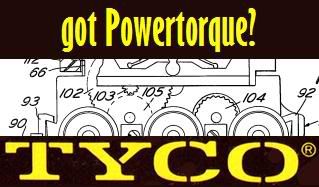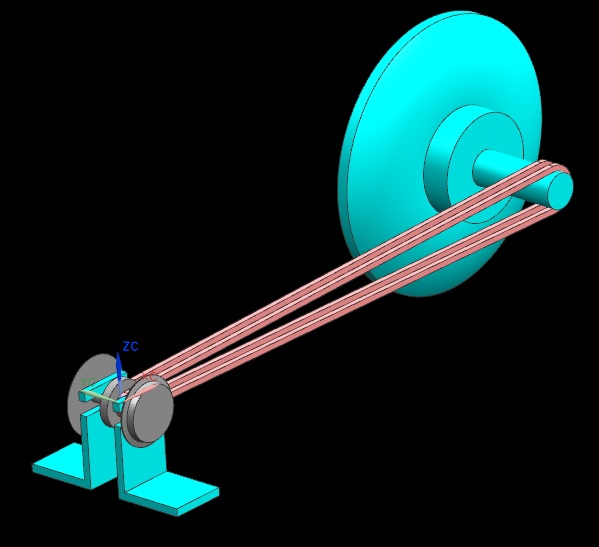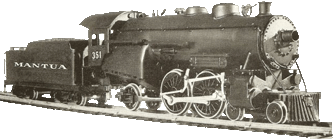|
|
 Posted - October 20 2014 : 12:09:50 PM Posted - October 20 2014 : 12:09:50 PM





|
So, I'm having issues with my C-630, seems it doesn't agree with ballasted track! Now other than trying to regroove all the main is there a simple easy way of turning down these #%$@#$ flanges?
just me Ray... and just because I have Tyco doesn't mean I am not a model railroader
|
Country:  USA ~
Posts: 506 ~
Member Since: April 03 2011 ~
Last Visit: April 20 2023 USA ~
Posts: 506 ~
Member Since: April 03 2011 ~
Last Visit: April 20 2023
|
 Alert Moderator
Alert Moderator
|
|
|
|
 Posted - October 20 2014 : 4:34:55 PM Posted - October 20 2014 : 4:34:55 PM




|
Run it slow upside down and use a file. Just very little at a time.
" Heck with counting 'em rivets, TRAINS ARE FOR FUN! Not called the Mad Scientist for nothing either!"
|
Country:  USA ~
Posts: 3145 ~
Member Since: May 07 2007 ~
Last Visit: April 04 2024 USA ~
Posts: 3145 ~
Member Since: May 07 2007 ~
Last Visit: April 04 2024
|
 Alert Moderator
Alert Moderator

|
|
|
|
 Posted - October 20 2014 : 8:44:43 PM Posted - October 20 2014 : 8:44:43 PM






|
Is that the only engine you are having trouble with, or others as well? I'd imagine that there has to be a "ballast gauge" that will check your mainline for depth of ballast interference, atlhough I've never seen one. That has got to be important, though, to keep your track clear of ballast lumps near the rails.
jerry
" When life throws you bananas...it's easy to slip up"
|
Country:  USA ~
Posts: 3974 ~
Member Since: January 04 2009 ~
Last Visit: January 11 2019 USA ~
Posts: 3974 ~
Member Since: January 04 2009 ~
Last Visit: January 11 2019
|
 Alert Moderator
Alert Moderator

|
|
|
|
 Posted - October 20 2014 : 11:50:15 PM Posted - October 20 2014 : 11:50:15 PM




|
quote:Run it slow upside down and use a file. Just very little at a time.
Originally posted by Redneck Justin - October 20 2014 :  4:34:55 PM
|
Wouldn't that get metal filings in the motor and gears?
Glenn
I was thinking of the immortal words of Socrates, who said, "... I drank what?"
|
Country:  USA ~
Posts: 1486 ~
Member Since: December 13 2008 ~
Last Visit: April 02 2024 USA ~
Posts: 1486 ~
Member Since: December 13 2008 ~
Last Visit: April 02 2024
|
 Alert Moderator
Alert Moderator

|
|
|
|
 Posted - October 21 2014 : 12:00:37 AM Posted - October 21 2014 : 12:00:37 AM





|
quote:Is that the only engine you are having trouble with, or others as well? I'd imagine that there has to be a "ballast gauge" that will check your mainline for depth of ballast interference, atlhough I've never seen one. That has got to be important, though, to keep your track clear of ballast lumps near the rails.
jerry
Originally posted by AMC_Gremlin_GT - October 20 2014 :  8:44:43 PM
|
yes Jerry the C-630 is the only one....most likely because its the only one with original tyco style wheels
just me Ray... and just because I have Tyco doesn't mean I am not a model railroader
|
Country:  USA ~
Posts: 506 ~
Member Since: April 03 2011 ~
Last Visit: April 20 2023 USA ~
Posts: 506 ~
Member Since: April 03 2011 ~
Last Visit: April 20 2023
|
 Alert Moderator
Alert Moderator

|
|
|
|
 Posted - October 21 2014 : 12:47:11 AM Posted - October 21 2014 : 12:47:11 AM




|
It's probably more work in the short run, but in the long run, it'd likely be less work to fix the real problem. Your flange ways are not supposed to be plugged up with ballast.
Trying to file down the flanges raises the question: "are all axles powered?" If not, just running it upside down against a file does little for the unpowered axles. Another question: "Are all the wheels and gears pressed on the axles strongly enough to withstand the filing?"
Also, do you know how well the engine will track and run on smaller flanges that may not be contoured the same as on a wheel that was made for smaller flanges? The shape of the flanges is as important as their size.
You also have to ask yourself if this one engine will be the last and only equipment you'll ever want to run that has big flanges.
Except in grade crossings and places where tracks are laid in gravel roadways, most tracks are not ballasted above the tie tops.
Carpe Manana!
|
Country:  USA ~
Posts: 2353 ~
Member Since: September 17 2013 ~
Last Visit: April 18 2024 USA ~
Posts: 2353 ~
Member Since: September 17 2013 ~
Last Visit: April 18 2024
|
 Alert Moderator
Alert Moderator

|
|
|
|
 Posted - October 25 2014 : 8:16:08 PM Posted - October 25 2014 : 8:16:08 PM




|
The best way to do it is to pop one wheel off the axle, chuck the axle in a drill and carefully turn the flange to profile while checking with an NMRA gauge. You can get the brass wheels off with a puller, or support them in a vise and tap the axle out with a punch if you don't have one.
The Tyco Depot
|
Country:  USA ~
Posts: 3927 ~
Member Since: June 20 2007 ~
Last Visit: November 19 2015 USA ~
Posts: 3927 ~
Member Since: June 20 2007 ~
Last Visit: November 19 2015
|
 Alert Moderator
Alert Moderator

|
|
|
|
 Posted - October 27 2014 : 8:10:52 PM Posted - October 27 2014 : 8:10:52 PM





|
quote: quote:Is that the only engine you are having trouble with, or others as well? I'd imagine that there has to be a "ballast gauge" that will check your mainline for depth of ballast interference, atlhough I've never seen one. That has got to be important, though, to keep your track clear of ballast lumps near the rails.
jerry
Originally posted by AMC_Gremlin_GT - October 20 2014 :  8:44:43 PM
|
yes Jerry the C-630 is the only one....most likely because its the only one with original tyco style wheels
Originally posted by rgcw5 - October 21 2014 :  12:00:37 AM
|
What code is your track? Perhaps it's not hitting stray ballast, but the nubs on the plastic ties which hold the rails. Just a thought.
I seem to remember a few of my engines hitting rock in a section of heavily ballasted track on my old layout. I believe I ended up just dragging a screwdriver along the inside edge of each rail and then vacuuming any loose chunks off the track.
|
Country:  Canada ~
Posts: 3319 ~
Member Since: September 22 2006 ~
Last Visit: April 07 2024 Canada ~
Posts: 3319 ~
Member Since: September 22 2006 ~
Last Visit: April 07 2024
|
 Alert Moderator
Alert Moderator

|
|
|
|
 Posted - October 28 2014 : 10:34:33 AM Posted - October 28 2014 : 10:34:33 AM





|
Cheez,
Its code 100 atlas, and I learned something after replacing a turnout at my brewery last night, 2/3 of the track, my brother did and he just "did it" and was doing a more astetic (realistic) look(which now is making some sense) so, yeah.... I gotta do the "drag" on the tracks 
just me Ray... and just because I have Tyco doesn't mean I am not a model railroader
|
Country:  USA ~
Posts: 506 ~
Member Since: April 03 2011 ~
Last Visit: April 20 2023 USA ~
Posts: 506 ~
Member Since: April 03 2011 ~
Last Visit: April 20 2023
|
 Alert Moderator
Alert Moderator

|
|
|
|
 Posted - November 27 2014 : 3:11:41 PM Posted - November 27 2014 : 3:11:41 PM




|
Perhaps it's a bit late to chime in, but I have similar issues with Lima and AHM locomotives from the 70s. They all have the "pizza wheel" flanges. I have had some success using a Dremel tool with the grinding wheel atttachment and running it on the lowest setting against the flanges to gradually grind them down.
It works well on unpowered wheels, too. Be sure to take your time. I tested a Lima FP 45 six-axle unit through code 83 switches and it went smoothly - it cleared the "spike heads", no catching, binding or derailing.
Be sure to take a bit off at a time and let the wheels cool down. If they are metal with plastic insulating on one side you could overheat the wheel and melt the plastic.
quote:So, I'm having issues with my C-630, seems it doesn't agree with ballasted track! Now other than trying to regroove all the main is there a simple easy way of turning down these #%$@#$ flanges?
Originally posted by rgcw5 - October 20 2014 :  12:09:50 PM
|
|
Country:  Canada ~
Posts: 22 ~
Member Since: February 16 2014 ~
Last Visit: December 02 2021 Canada ~
Posts: 22 ~
Member Since: February 16 2014 ~
Last Visit: December 02 2021
|
 Alert Moderator
Alert Moderator

|
|
|
|
 Posted - November 27 2014 : 3:27:48 PM Posted - November 27 2014 : 3:27:48 PM




|
| They should run fine on code 100 rail but it is common to get ballast built up around the big spike detail on flextrack. Also, check the gauge of your wheelsets first, if the gauge is narrow the wheels will ride a bit lower than if they are properly gauged. Did you look to see if the traction tires are still there? If the tires have rotted away..there is the problem. Often the groves for the tires build up with gunk and it might appear that the tire is there when in fact it is long gone. I run my all original C-630s on track from code 83 up to 100 and have never had the problem unless a tire is missing.
|
Country:  USA ~
Posts: 867 ~
Member Since: December 21 2013 ~
Last Visit: December 08 2016 USA ~
Posts: 867 ~
Member Since: December 21 2013 ~
Last Visit: December 08 2016
|
 Alert Moderator
Alert Moderator

|
|
|
|
 Posted - November 28 2014 : 2:40:03 PM Posted - November 28 2014 : 2:40:03 PM




|
rgcw5:
I agree with the people who say to clean the stray ballast off the track. Code 100 is high enough to run even the old AHM flanges. Tyco flanges aren't as tall as those. No sense risking stripped gears to fix something that isn't broken, when the track is easy (if a little tedious) to correct.
I usually take the end of a flat screwdriver and run it around, held against the rail web on the inner side. Sometimes I use a single edge razor blade too.

|
Country:  USA ~
Posts: 432 ~
Member Since: March 04 2008 ~
Last Visit: December 28 2018 USA ~
Posts: 432 ~
Member Since: March 04 2008 ~
Last Visit: December 28 2018
|
 Alert Moderator
Alert Moderator

|
|
|
|
 Posted - November 28 2014 : 4:47:04 PM Posted - November 28 2014 : 4:47:04 PM




|
Anyone have suggestions for turning down the flanges on an AHM mallet for use on a Code 80 layout? Or am I better off getting replacement drivers, and if so, what ones?
--CRC
|
Country:  USA ~
Posts: 930 ~
Member Since: January 25 2012 ~
Last Visit: August 23 2023 USA ~
Posts: 930 ~
Member Since: January 25 2012 ~
Last Visit: August 23 2023
|
 Alert Moderator
Alert Moderator

|
|
|
|
 Posted - December 02 2014 : 09:30:55 AM Posted - December 02 2014 : 09:30:55 AM




|
quote:Anyone have suggestions for turning down the flanges on an AHM mallet for use on a Code 80 layout? Or am I better off getting replacement drivers, and if so, what ones?
Originally posted by PRR 4800 - November 28 2014 :  4:47:04 PM
|
PRR:
About twenty years ago, a reader submitted his setup to MR for grinding down AHM flanges. I remember the details very well, but not the exact issue - it was in MR Workshop or Clinic, I think. He recommended his improvised setup despite having a lathe, because the old AHM driver centers were fragile and their metal tires slipped easily. The setup was designed to avoid heavy stresses or heat buildup.
I've drawn up the grinding fixture in CAD. I've never used this setup myself for AHM drivers, but I tested it with some plastic wheelsets, at the time, and it did work.

Two metal strips were bent into ells and slotted partway through their uprights. A wheelset was placed between them and driven by a rubber band or rubber bands looped around its axle and the output shaft of a small AC motor. The original motor was from an old food mixer. You could use a drill motor with a piece of rod chucked in it. Speed was high (maybe 2000 rpm?) but torque was minimal. "Light finger pressure on the driver tire should be enough to stop the wheel from rotating". Plastic uprights were recommended when using this setup with plastic-axle wheelsets.
The flanges were ground down by brushing a cutoff wheel in a Dremel tool lightly against the flange (obliquely ) while the wheelset spun. (A grinding wheel also works, I find.) The reader also recommended that any bulging traction rings be carefully trued after the flanges were ground, in the same fixture ( I guess with an emery board or sandpaper or something, he didn't specify a tool for it).
Despite the deliberate lack of any radial cutting action (which would tend to slip the metal tires), the job goes quicker than you might think. I found it easy to take too much material off plastic wheelsets this way. I would recommend adding some kind of steady rest for the hand holding the Dremel tool. Nothing complicated, just something to rest the hand on - a block of wood would do. Taking hand steadiness out of the equation is a key to delicate work with simple tools.
The reader ended with a subtle suggestion that more information on rebuilding low-cost trainshow equipment for renewed service on model railroads would be a Good Thing for other MR readers. No significant evidence that the hint was ever taken. :/

Edited by - Autobus Prime on December 02 2014 09:32:43 AM
|
Country:  USA ~
Posts: 432 ~
Member Since: March 04 2008 ~
Last Visit: December 28 2018 USA ~
Posts: 432 ~
Member Since: March 04 2008 ~
Last Visit: December 28 2018
|
 Alert Moderator
Alert Moderator

|
|

